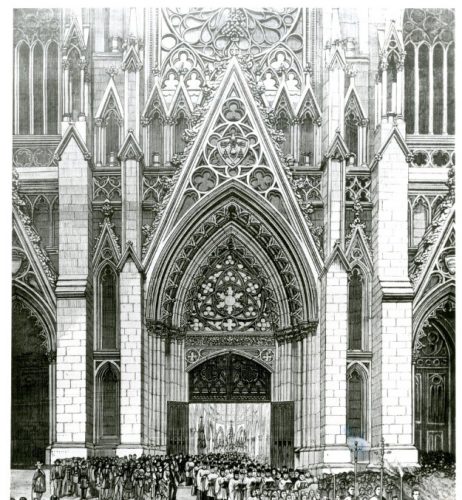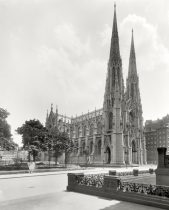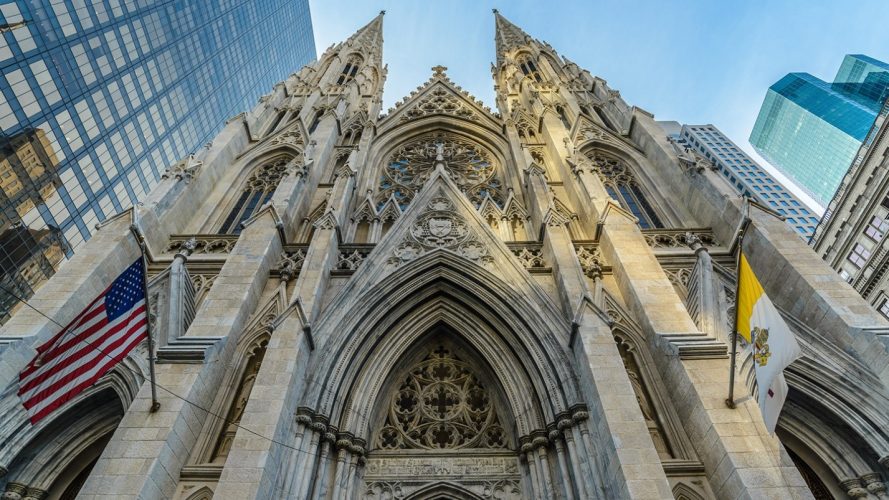Saint Patrick’s Cathedral, the Cathedral Church of the Roman Catholic Archdiocese of New York, is located on 5th Ave between 50th and 51st streets in Manhattan, New York, NY. The building is widely regarded and venerated as one of the most beautiful architectural gems, houses of worship, and cathedral churches in the country, let alone New York City. Located directly across from Rockefeller Center, it is visited by tourists, commuters, and city residents regularly in the heart of New York City. It stands as a monument and witness to the living faith, hope, and charity at the center of Manhattan. The story of Saint Patrick’s Cathedral is an evolving history with more than just a historical account of construction. Rather, the building is a testimony to the Catholic Christians’ perseverance in living the faith they profess and providing a beacon of light to the world.
The site of Saint Patrick’s was purchased in March of 1810 by a group of priests for $11,000. At the time of the purchase, the property hosted a mansion which was used as a school run by the Jesuits, a religious congregation of the Roman Catholic Church.[i] Trappist Monks, another religious congregation of the Church, occupied the property to the year 1814.[ii] In 1827, trustees and committees of the Archdiocese of New York discussed the possibility of purchasing a new property for cemetery burial purposes. The property which was now vacated by the Trappist Monks was evaluated and “a cursory examination would have revealed the nature of the soil, which rendered it entirely unfit for burial purposes. Fortunately, however, the trustees did not make any examination, and thus secured for St. Patrick’s Cathedral one of the most beautiful and valuable sites in the United States”.[iii]

Years passed by and Archbishop Hughes, the metropolitan bishop of the Archdiocese of New York, anticipated the need to accommodate the growing Catholic population of New York in the mid-1800s. With the influx of immigrants with strong Catholic roots, especially from Ireland and other European nations, Catholic worship and practice was intentionally sought by immigrants. Following the American Revolution, it was permissible.[iv] Thus, he announced his plans to “to erect a Cathedral in the City of New York that may be worthy of our increasing numbers, intelligence and wealth as a religious community, and at all events, worthy, as a public architectural monument, of the present and prospective crowns of this metropolis of the American continent.”[v] In 1852, he contracted Mr. James Renwick, an architect of New York to begin drawing up plans for the Cathedral church.[vi] After years of discussion, further planning, and architectural development, a plan was finally agreed upon in the late 1850s. The architects prepared an expense report for the Archdiocese. Cathedral construction in white marble was approximately $850,000, not including the altar construction, chapel furnishings, or organs.[vii] As the plans were completed and construction was set to begin,

the Archbishop began fundraising efforts in the local parish churches and among the clergy of the Archdiocese. In highlighting the monumental architectural plans, he implored people for their financial support. In one note to a brother priest dated June 16, 1858, Archbishop Hughes said, “I am preparing to lay the corner-stone of our great new Cathedral on Sunday, the fifteenth of August at four o’clock P.M. It is to be Gothic, 322 feet long, 97 feet wide, a transept of 172 feet and an elevation from floor to crown point of the ceiling in the clerestory of 100 feet. I suppose it will cost one million dollars. I am not obliged to be alive when it shall be completed, but I think it is my duty to see it begun.”[viii]
The cornerstone was laid in 1858 as Archbishop Hughes planned and construction began. The construction is said to have progressed rather quickly after it began. During the American Civil War, construction slowed down and was halted, but continued a few years later in 1865. As they neared its completion in 1878, Cardinal John McCloskey, Archbishop Hughes’ successor hosted a “fundraising fair” in the new cathedral to fundraise the final funds needed to complete the Cathedral construction and purchase the necessary furnishings.[ix] Finally, Saint Patrick’s was formally opened to the public in May of the following year, 1879 on the Feast of Saint Gregory VII, Pope and Confessor.[x] The Body of Christ, the Church rejoiced, people were awestruck, and all stood amazed at the architectural beauty and fitting place for worship of Almighty God. Cardinal McCloskey remarked that all people are to “rejoice in the consummation of this great work. They behold the greatest church edifice of the New York, the ornament of their city, the temple of religious art, and the powerful means of preserving morality amongst those who shall worship within its walls.”[xi] Saint Patrick’s Cathedral, now open became widely regarded, publicly venerated, and universally adored church dedicated to Almighty God, the memory of Saint Patrick, patron of Irish-Catholics, and the powerful glory of Catholics in America.

Since its completion in 1879, smaller projects and finishing touches were made, but the Cathedral has since maintained its original structure, style, and magnificence. Projects since the completion in 1879 have included the construction of the Cathedral spires, Lady Chapel, Rectory, and Cardinal’s Residence in years that followed through the late 1800s and early 1900s. Eventually, renovative and restorative projects were undertaken through the 1900s that all preserved and continued to ensure the vision of the late Archbishop Hughes and his vision for the Cathedral Church of the Archdiocese of New York. The Landmarks Preservation Commission records that, “St. Patrick’s Cathedral represents the epitome of the Gothic Revival in New York City” and continues on to say that “On the basis of a careful consideration of the history, the architecture and other features of this building, the Landmarks Preservation Commission finds that St. Patrick’s Cathedral and Lady Chapel, and Rectory and Cardinal’s Residence have a special character, special historical and aesthetic interest and value as part of the development, heritage and cultural characteristics of New York City.”[xii] Today, the Cathedral Church of the Archdiocese of New York and seat of the Archbishop still stands faithfully to its original architectural vision and design. Furthermore, it stands as a fitting place to offer prayer and worship to God and a place for the community of the Church to unite in faith.
Saint Patrick’s Cathedral has become a meeting place for immigrants, tourists, Catholics and Christians, and all people since its construction. It has also become one of the most widely known and visited churches and landmarks of Manhattan, New York, and the country at large. The primary highlights of the Cathedral include the beautiful main sanctuary, side altars and chapels, and the Lady Chapel dedicated to the Blessed Virgin Mary. The entire building in its architectural splendor raises eyes, hearts, and minds upwards to the highest heavens.[xiii]
Upon entering the Cathedral, the immediate focal point is forward and upward. Gothic architecture emphasizes this attention upwards and designs its buildings in such a way that this attention is leveraged to draw attention to what is important. Mindful of this, the first highlight would be the main sanctuary which is the center of the liturgical and prayerful action of Catholic worship.[xiv] Up from the nave (the ground level with pews), the sanctuary comprises the altar (the table where the Eucharistic Sacrifice and consecration takes place), the pulpit (the raised platform where the Scripture Readings are proclaimed and where preaching is offered from), the Cathedra (the bishop’s seat for teaching and celebrating the liturgy, the public prayer of the Church), and the seating for the other liturgical ministers and people involved in the celebration of the Holy Mass or other service. The attention captured from entering the Cathedral to the sanctuary is then directed upwards to the heavens through the lofty ceilings, arches, and gothic style curved ceilings to a high point. This serves as a reminder that all of life, worship, and prayer is directed toward Heaven and eternal life with God.[xv]
Another highlight would be the Lady Chapel, which serves as a smaller, more private prayer space for smaller congregations. In the Lady Chapel, the Blessed Sacrament, the Real Presence of God is reposed for adoration and prayer by the faithful. The Lady Chapel serves as a highlight since its walls are adorned by some of the most beautiful stain-glass windows representing each mystery of the Holy Rosary, a prayerful meditation on the life of Jesus Christ and Mary, the Blessed Virgin. In his historical account of the History of St. Patrick’s Cathedral, John Farley says that: “The Lady Chapel is indeed the Holy of Holies. It is difficult at this writing to realize what a magnificent contrast will break upon the visitor as they pass from the heavy, severe tone of the Cathedral proper, to the finer lines and more delicate tracery of the Lady chapel, and the harmonious colors of its jewel-like windows.”[xvi]
One last of the many highlights of Saint Patrick’s would be the side altars and small chapels flanking the sides of the Cathedral’s nave. The side altars and chapels are dedicated to the memory of saints of various walks of life, ethnicities and nationalities, and stories and testimonies of faith. These smaller altars and chapels offer places for priests to privately celebrate the Holy Mass and offer the celebration with small groups of people. Furthermore, they provide space for intimate, personal prayers to be offered to God in seeking the intercession of holy people who have died.[xvii] The altars are dedicated to the holy memory of: Saint de la Salle, Saint Augustine, Saint Veronica, Saint Anthony of Padua, Saint John the Evangelist, and Saint Stanislaus Kostka.[xviii] To pray in these dedicated chapels, learn the lives of the Saints, or holy ones, and see how the Catholic immigrant population of New York is represented through their Saintly devotions is certainly a highlight of Saint Patrick’s Cathedral. It is commonly understood that much of the history of New York City is marked by immigration from Europe through the 19th century. Irish immigrants made up a predominant group moving into the city with their strongly rooted Catholic devotion.
Primary source materials reveal the excitement, anticipation, and faithful devotion of the people of New York City through the time of the Cathedral’s construction and opening in New York. The Sun, a historic New York newspaper captures this well in its October 28, 1878 issue: “The great fair at St. Patrick’s Cathedral now in progress, very naturally excites the keenest interest among the whole of the Roman Catholic population of the city. It will also be attended or watched anxiously by many Protestants, for it has been projected on a grand scale, and its object is to aid in the completion of an imposing ecclesiastical structure (…) whose most solemn and gorgeous ceremonies will there be celebrated with a pomp to which we are unaccustomed in this country.”[xix] Primary source materials also demonstrate how the growing population of Catholics in America necessitates a more formalized “ecclesiastical structure”. This structure and the need for it is manifested through the growing need for hierarchy and organization which attests to the makeup of America including Catholics. Saint Patrick’s Cathedral and the media surrounding its construction, completion, and opening attest to just that. Furthermore, primary source materials, most especially photographs, reveal the developing culture of New York City, Sunday as a day of prayer and rest, and the role of faith and practice of religion in the city society.
All these elements of the history of Saint Patrick’s Cathedral and its very building structure reveal many truths about New York City. Furthermore, they reveal a lot about the history of New York City and its role today as a cultural melting pot and prominent city of the United States. These elements provide a look into the role of Catholicism, Christianity, religious practice at large, and its relationship to society and day-to-day life. Through the history of Saint Patrick’s, look at the Civil War and how it affected society. The history allows people to look with an eye towards New York City as a diverse, all-embracing through the role of immigration and the various immigrant groups represented.
These new perspectives, various looks, and revealing truths of faith, hope, and charity can begin with a simple visit to Saint Patrick’s Cathedral, the Cathedral Church of the Roman Catholic Archdiocese of New York in the very heart of Manhattan.
Endnotes:
[i] Farley, John M. History of St. Patrick’s Cathedral. Society for the Propagation of the Faith, 1908., 112.
[ii] Ibid., 112.
[iii] Ibid., 113.
[iv] Ibid., 123.
[v] “Historical Timeline.” St. Patrick’s Cathedral, Archdiocese of New York, 2018, saintpatrickscathedral.org/historical-timeline
[vi] Farley, John M. History of St. Patrick’s Cathedral. Society for the Propagation of the Faith, 1908., 115.
[vii] “Historical Timeline.” St. Patrick’s Cathedral, Archdiocese of New York, 2018, saintpatrickscathedral.org/historical-timeline
[viii] Farley, John M. History of St. Patrick’s Cathedral. Society for the Propagation of the Faith, 1908., 122.
[ix] “Historical Timeline.” St. Patrick’s Cathedral, Archdiocese of New York, 2018, saintpatrickscathedral.org/historical-timeline
[x] Farley, John M. History of St. Patrick’s Cathedral. Society for the Propagation of the Faith, 1908., 130.
[xi] Ibid., 132.
[xii] “St. Patrick’s Cathedral and Lady Chapel and Rectory and Cardinal’s Residence.” New York City Landmark’s Preservation Commission, New York, 19 Oct. 1966. http://s-media.nyc.gov/agencies/lpc/lp/0267.pdf
[xiii] Nichols, Aidan. The Shape of Catholic Theology: An Introduction to Its Sources, Principles, and History. United States, Liturgical Press, 1991., 192-193.
[xiv] Ibid., 197.
[xv] Ibid., 189.
[xvi] Farley, John M. History of St. Patrick’s Cathedral. Society for the Propagation of the Faith, 1908., 170.
[xvii] Nichols, Aidan. The Shape of Catholic Theology: An Introduction to Its Sources, Principles, and History. United States, Liturgical Press, 1991., 197.
[xviii] Ibid., 209-214.
[xix] “St. Patrick’s Cathedral.” The Sun, 28 Oct. 1878, pp. 2. New York State Historic Papers, nyshistoricnewspapers.org/.
